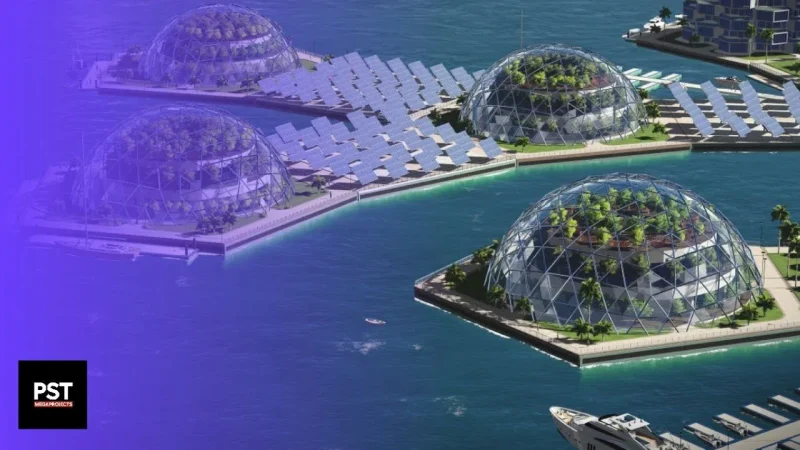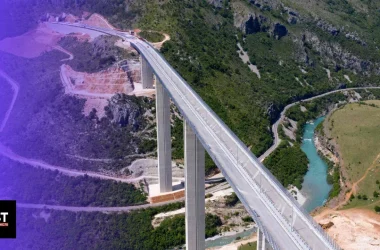Hong Kong is currently undertaking its most awe-inspiring and largest-ever infrastructure megaproject to date: The Kau Yi Chau Artificial Islands.
This land reclamation project is set to be the largest in the world, being two times larger than Dubai’s famous Palm Jumeirah. But, with a staggering $80 billion price tag, many have asked: Will this megaproject completely bankrupt the city?
To answer this question, we’ll examine the details of this ambitious megaproject and the surprising reason Hong Kong is building it, talk about the immense criticism it faces, and all the obstacles facing Hong Kong in its mission to make these artificial islands inhabitable by 2032.
The Kau Yi Chau Artificial Islands
The Kau Yi Chau Artificial Islands project was previously known as the Lantau Tomorrow Vision when it was announced by the Hong Kong government in 2019. The government described it as one of the world’s largest artificial island projects and Hong Kong’s largest infrastructure project to date.
Basically, it’s a large-scale land reclamation project that plans to build three artificial islands, covering around 1,000 hectares of land, among the region’s natural islands between Lantau and Hong Kong Island.
Once that’s done, the Hong Kong government will construct 260,000 housing units, of which 70% will be for public housing. In addition to the residential units, the project will include the infrastructure of a core central business district, which will create 270,000 job opportunities.
Hong Kong’s Housing Problem
When we hear of artificial islands, we usually think of projects like Palm Jumeirah in Dubai, which was built to lure tourists to the city.
On the other hand, Hong Kong’s megaproject is the city’s response to a housing problem that it has been struggling with for a very long time. You see, Hong Kong’s housing market is considered one of the most expensive in the world, thanks to the city’s position as a global financial hub.
In fact, one 60-square-meter apartment in the center of Hong Kong would cost $1.7 million, an unbelievable 47,122% increase from the average monthly income of approximately $3,600.
These incredibly high prices are a result of strict government regulations on real estate development activities, as well as the types of buildings that can be built. But, the biggest of all is that the supply of land, which the government controls, continues to diminish.
This is because a lot of land is privately owned by real estate developers in Hong Kong, who collectively own more than 1,000 hectares of land they claim they can’t develop. They blame the government for the lack of transport infrastructure to support the projects. In addition, many real estate developers in Hong Kong are holding onto empty apartments and refusing to sell them because they expect that prices will keep going up.
Therefore, the Hong Kong government refused to sit back while private developers did nothing with their lands and decided that the best way to create affordable housing was to build on new reclaimed lands in the South China Sea.
The Criticism
The plan wasn’t well received by the people it was meant to serve. First, the project’s massive price tag shocked the citizens, and it was heavily criticized.
The price of the land reclamation alone is around $80 billion, and engineers estimate that the entire project would cost $115 billion, once you account for the costs of the infrastructure needed to support life on the artificial islands. Despite concerns over the cost, the Hong Kong government approved the project’s first phase a year after it was announced and now seems very intent on finishing it.
The city’s finance chief, Paul Chan Mo-Po, even responded to the backlash by suggesting that the government could issue bonds and collaborate with private developers to fund the land reclamation.
But, even if the government managed to sell the reclaimed lands to private developers or foreign investors to save costs, it would only generate around $51 billion in revenue, according to estimations by Jason Poon, a veteran Hong Kong-based engineer. Not only that but it’s also estimated that the city’s fiscal reserves may be drained in a decade or so if the government pursues the mega project.
Aside from the megaproject’s financial risks, environmentalists attacked it over fears that the construction would cause irreversible environmental damage to the region. In a 2020 submission to the Legislative Council, a local environmental group called Green Earth said that land reclamation of this scale would certainly destroy natural habitats and marine life.
The marine life includes the Chinese pink dolphin, which disappeared from the area and was thought to be extinct thanks to boat activity. Still, it made a comeback during the pandemic when boat activities stopped and is now a Grade 1 national key protected animal. In addition to that, the construction will require a huge supply of marine sand, which can only be attained through sand mining, which will destroy river and sea beds in the mining areas.
But, all of this wasn’t enough to deter the current administration under John Lee, which stressed that the city would need an extra 1 million apartment units to meet the needs of the 8.1 million population by 2041.
This argument, however, makes zero sense, especially when you consider that another development project in Hong Kong, the Northern Metropolis developmental project, is set to produce 900,000 residential units in the coming decade, so why are the artificial islands needed when another project that will do the same thing is being built?
Aside from that, the government’s population projections were questioned by many citizens because no one expected the population to keep growing. This is because the city’s population dropped from 7.41 million in 2021 to 7.29 million in 2022, thanks to many middle-class families and professionals immigrating after the enactment of the controversial National Security Law in 2020, which grants sweeping powers to Chinese authorities to handle national security cases.
Economists in Hong Kong expect this immigration trend to continue for at least the next two to three years. Yet the government still projects that the city’s population will continue increasing.
But, the criticism didn’t end there. People also questioned the need to build a third central business district in Hong Kong, when the newly developed second one in east Kowloon still hasn’t delivered all of its promises, and its future growth looks uncertain.
The Challenges to the Artificial Islands
As mentioned above, the government approved the first phase of the project, which started with a three-year study of the construction’s environmental impact. The Hong Kong government said that if the project is found feasible, it will start construction. If not, the government will request even more environmental assessments.
In truth, we don’t have many details regarding the project’s first phase or how the initial environmental study went. Still, it’s common knowledge that projects like this one require rigorous feasibility studies and simulations to justify their needs and all of this results in even more costs.
And more costs are the last thing Hong Kong needs. According to Ernst & Young, the deficit will be $18.9 billion, and the Hong Kong Institute of Certified Public Accountants is also predicting a $16.2 billion deficit.
Suppose the fiscal deficit rises to $18.9 billion. In that case, it’ll be nearly 50% higher than the official estimates of $12.7 billion, so Hong Kong accountants are calling for the government to tweak or postpone the megaproject.
Another challenge Hong Kong faces is its aging population, which continuously rises yearly. In fact, Hong Kong’s population aged 65 and above increased by 4.40% in 2023, near its peak of 4.62% in 1976. This raises concerns over who would actually live in the artificial islands, especially since the younger generations are leaving Hong Kong.
Hong Kong’s exposure to China is also a source of concern since the mainland is struggling with its own economic crisis caused by a weakened real estate sector. An example of how China’s economic woes affect Hong Kong is very obvious in stocks in its exchange. Its benchmark index, the Hang Seng, fell sharply to 14,961 points, hitting a 15-month low on January 22 alone, reflecting the disappointment in the Chinese economy.
What’s Next?
Considering all of the challenges, we can conclude by saying that while this megaproject has a good cause, the Hong Kong government should still rethink it. There’s no reason for Hong Kong to undertake this massive and costly project, which still needs a lot of study.
Meanwhile, another project that could be prioritized instead is the Northern Metropolis. It will even provide housing to more people in a more natural location that doesn’t require reclaiming land from the sea.
Overall, neither of the projects is an immediate solution to Hong Kong’s housing problem, since they’re expected to be completed sometime after 2030. For now, we have to wait for the Hong Kong government to be more transparent and give more information about the project so it can answer the people’s questions and reassure them.
Despite the mystery surrounding this project, we can definitely see artificial islands or floating cities becoming common in the future, thanks to housing issues or climate change.
Disclaimer
Please visit and read our disclaimer here.









